Are you looking for a travelogue and guide to Wari Chora in Meghalaya?
If Yes, you are in the right place.
The popular tourist circuit of Meghalaya includes the districts of Khasi and Jaintia Hills.
Tourists who love sightseeing or adventure visit places like Shillong, Sohra, Wahkhen, Dawki and Mawlynnong.
But they miss on the places in other districts of Meghalaya.
The Garo Hills in the western part of Meghalaya have finally started receiving the tourism exposure it deserve.
Wari Chora has paved the way to more destinations in Garo Hills of Meghalaya.
Our 3-day 2-night Wari Chora tour itinerary also included a visit to Dombe Wari, Aginma Wari, Jadisil Fish Sanctuary, and Siju Cave.
About Wari Chora – Meaning
According to our local guide Mark, “Wari Chora is the land of the Seven Giant Serpents (Sangkni)”.
Wari is a Garo word meaning deep water while Chora refers to long. In other words, a deep river stretched between serpent shaped canyons.
Wari Chora is a place surrounded by canyons and the tranquil turquoise water of river Rongdik passes through it.

The Rongdik River flows from Wari Chora to Jawai Wari through Aginma Wari and then to Emangre.
The river then joins the Simsang River in Siju and eventually entering Bangladesh.
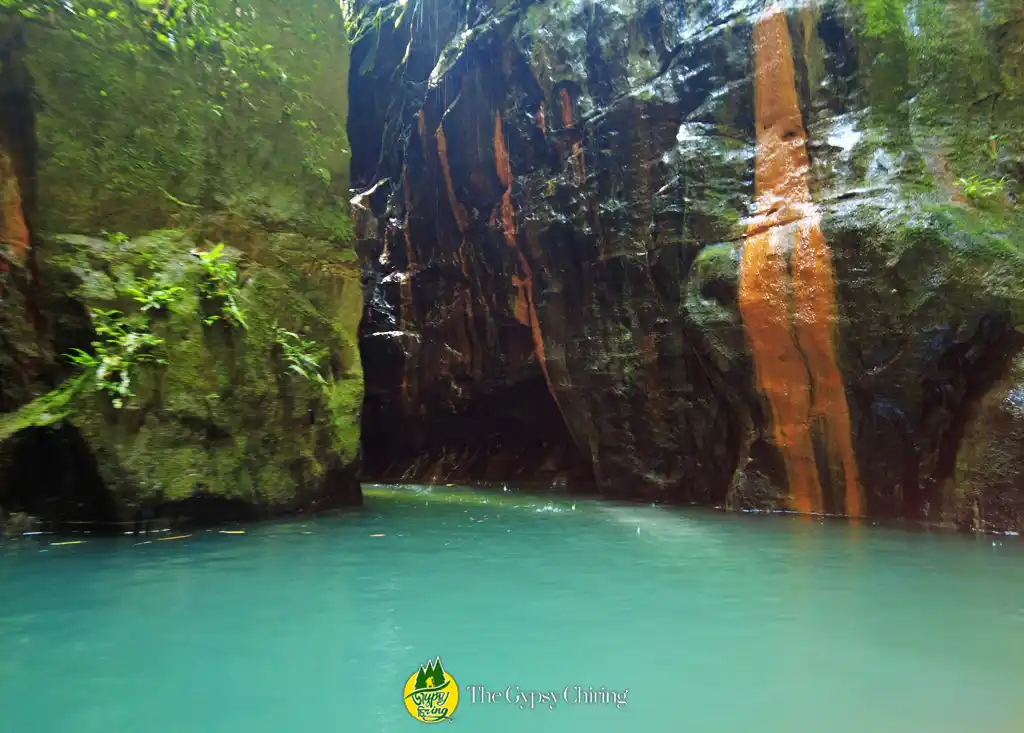
Wari Chora is not a village but a newly developed offbeat tourist spot.
It is a hidden gem located in between Pharomgre & Rekmangre Village of South Garo Hills of Meghalaya.
Wari Chora was first explored and promoted by Sir Bhuto Marak & his team.
The Indigenous Agro Tourism Cooperative Society Limited of Pharomgre & Rekmangre Village, Emangre Region Combine Tourism looks after the tourism of Wari Chora & Dombe Wari.
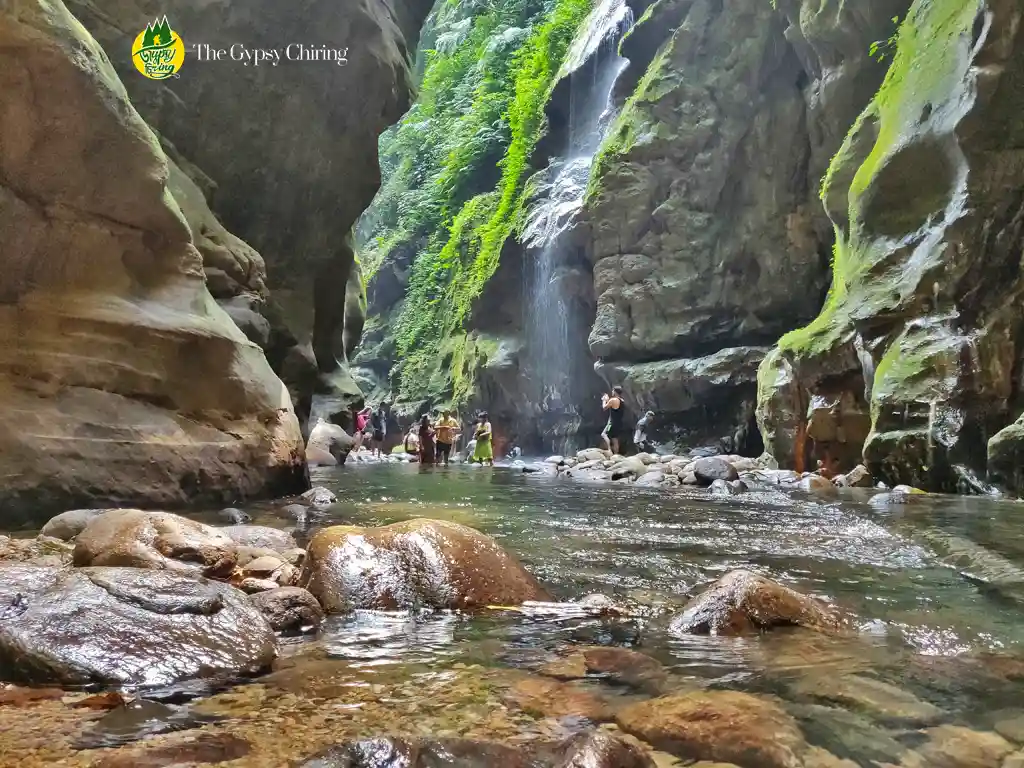
Wari Chora is not a town but a tourist spot in Meghalaya known for its heavenly magical landscape – its canyons, waterfalls and turquoise water.
Guwahati to Wari Chora – Our Journey
On April 7th, we started our journey from Guwahati led by our guide Tangseng of Baghmara Campers.
The journey from Guwahati to Wari Chora was done in two sections – First from Guwahati to Baghmara. Secondly from Baghmara to Wari Chora.
Guwahati to Baghmara – Day 1
A group of new travel friends from Shillong, West Bengal, Mumbai and Assam boarded the traveller vehicle to start the journey to a paradise called – Wari Chora.

We followed the route starting from Guwahati-Boko-Dhupdhara-Dudhnoi-Damra-Wageasi-Rongmil-Rongjen-Nengkhra-Nongalbibra-Jadi-Siju-Karukol-Baghmara.
Baghmara is the headquarters of the South Garo Hills District of Meghalaya.

We stopped at Dudhnoi in Assam for lunch and at Pathargittim for a sunset view in South Garo Hills on our way to Baghmara.
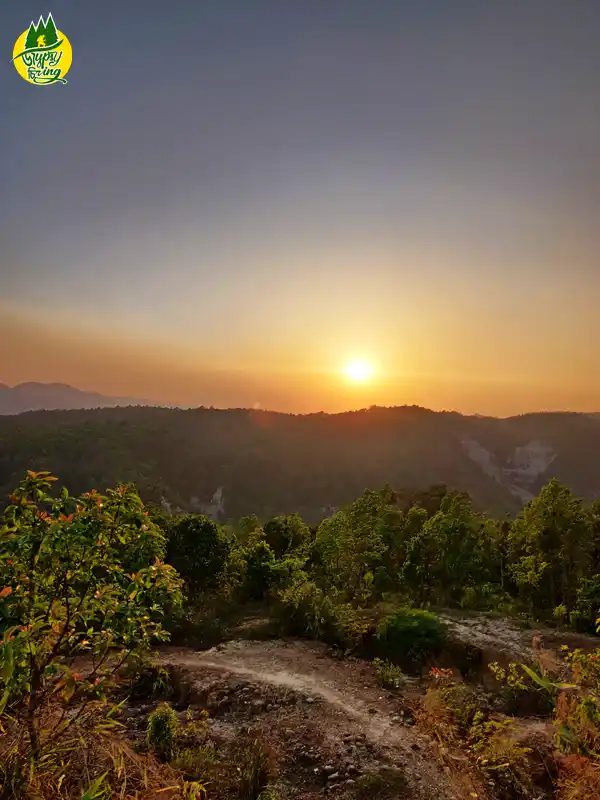
A journey that started at 11 am ended at 9 pm in Baghmara. The excitement and thoughts of seeing the canyons and the misty world of Wari Chora the next day made us forget how tiring the journey was.
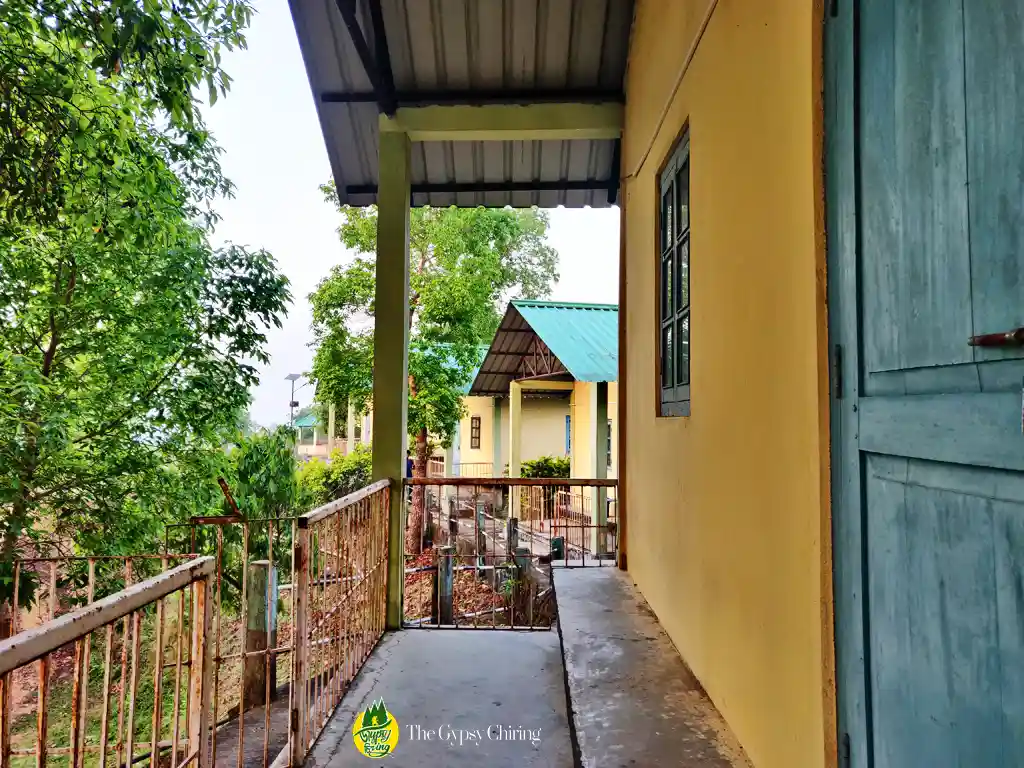
Baghmara to Wari Chora – Day 2
On the 2nd day, I went for a solo morning walk along the main road. As I felt the fresh breeze of Baghmara, a person returning from a walk greeted me at the Tourist Office Campus.
We introduced ourselves and spoke about Garo Hills. I loved the view of the distant Hills covered by clouds and birds chirping that morning.


2 hours of travel awaited us till Emangre. We reached Emangre around 9 am.
The Saturday Market in Emangre locally known as Emangre Salantini Bajal was in full swing.
While waiting for our 4×4 Vehicle we bought a few eatables and spent our time at the bank of river Rongdik.

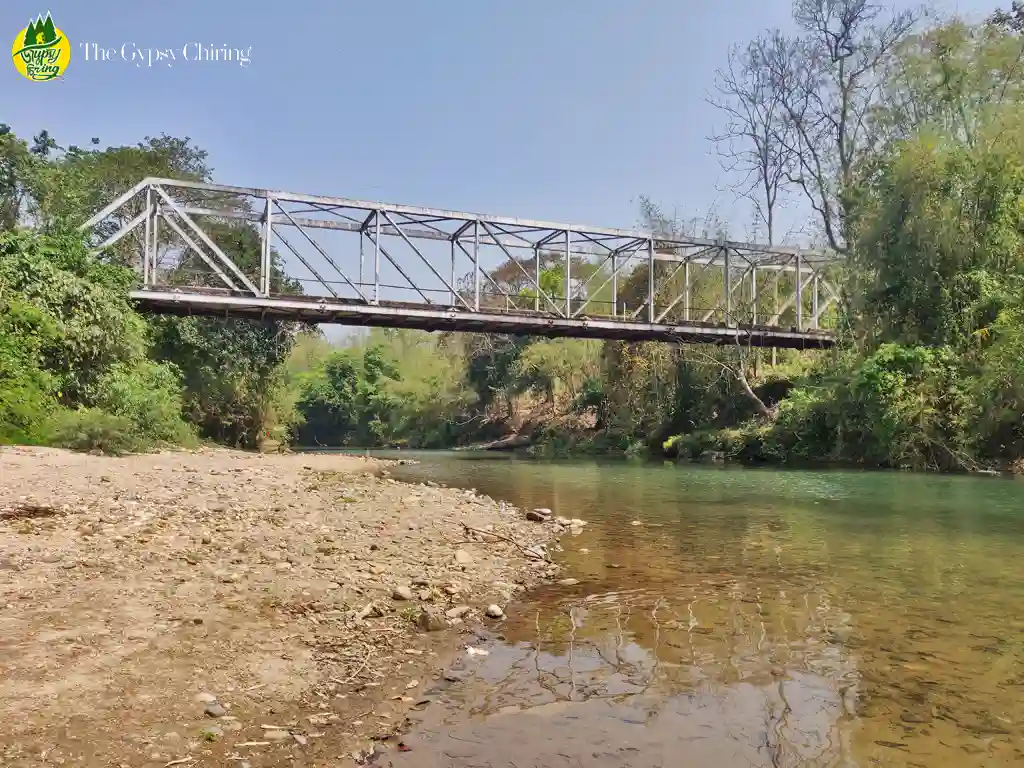
Emangre to Wari Chora Offroading Experience
From Emangre only a 4×4 vehicle can drop us till the start of the Wari Chora Trekking point.
Therefore, we hopped on the 4×4 Vehicle for the offroad adventure. I stood at the front to make space for others and a better view.
The road from Emangre Village to Rekmangre starts opposite the Market Area.
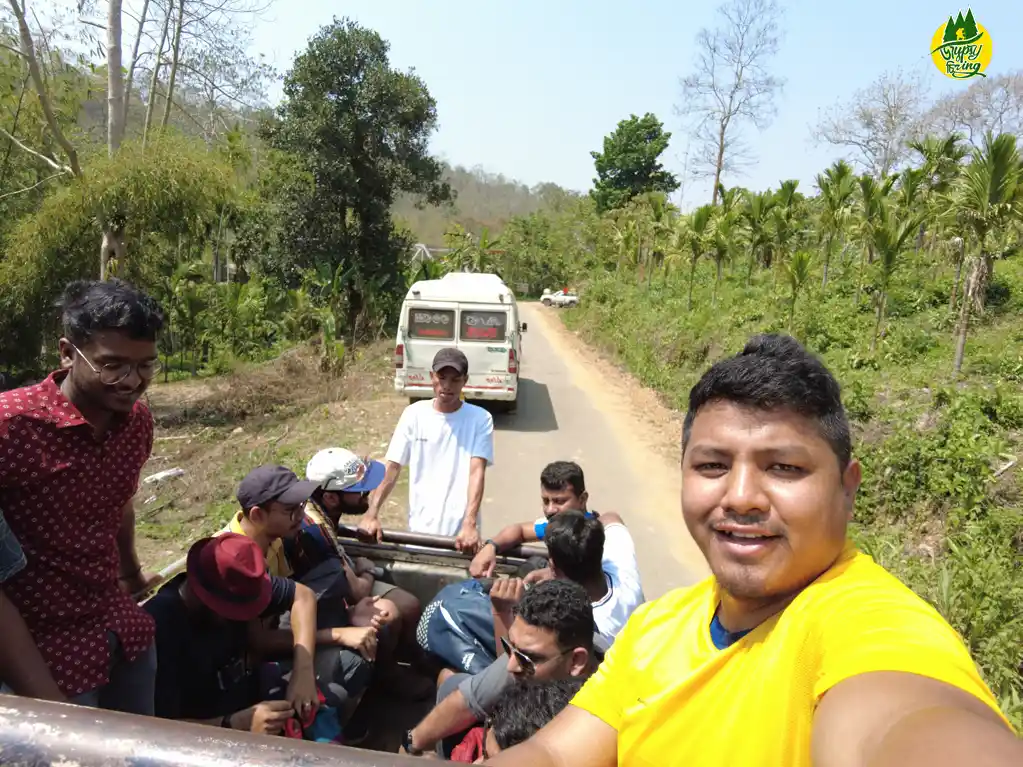

Though the Rekmangre road was bumpy, rugged and steep, I loved the view from the top.

After the settlement area, we crossed through the Emangre Community Reserve Forest. On one side was the valley and high distant hills and on the other some betel nut trees.

This experience of going off-road on steep roads reminded me of two past experiences.
Firstly, how I used to lie on the top of such vehicles while bringing harvested paddy from the fields during my childhood.
Secondly, exploring a riverside at Dambuk in Arunachal Pradesh.
It took about 40 minutes to reach the starting point of the trek. Tea stalls and snacks can be found after entering the gate.

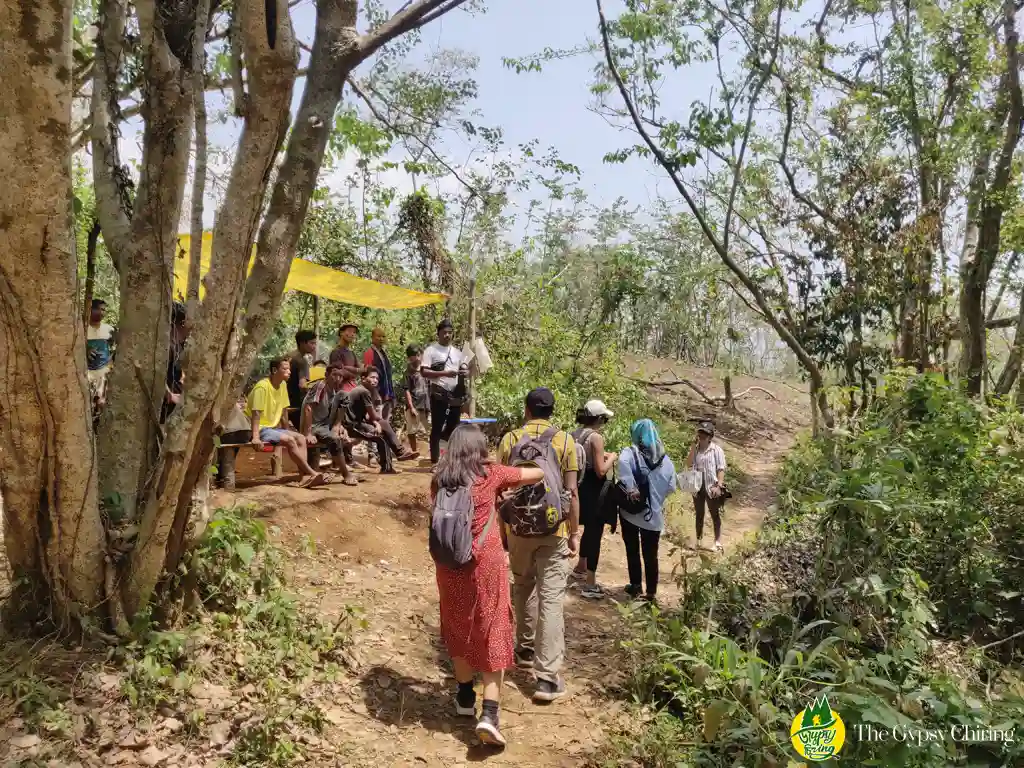
Things to do in Wari Chora
1. Trekking
A trek of 1.5 km downhill to Wari Chora starts from a cleared land into the forest.
The first part of the trail is mostly plain and easy. Local guides both from Baghmara Campers and the village accompanied us.

Walking for a few minutes, you will see a resting hut alongside a betel tree-cultivated area. The actual forest trail starts from this point.
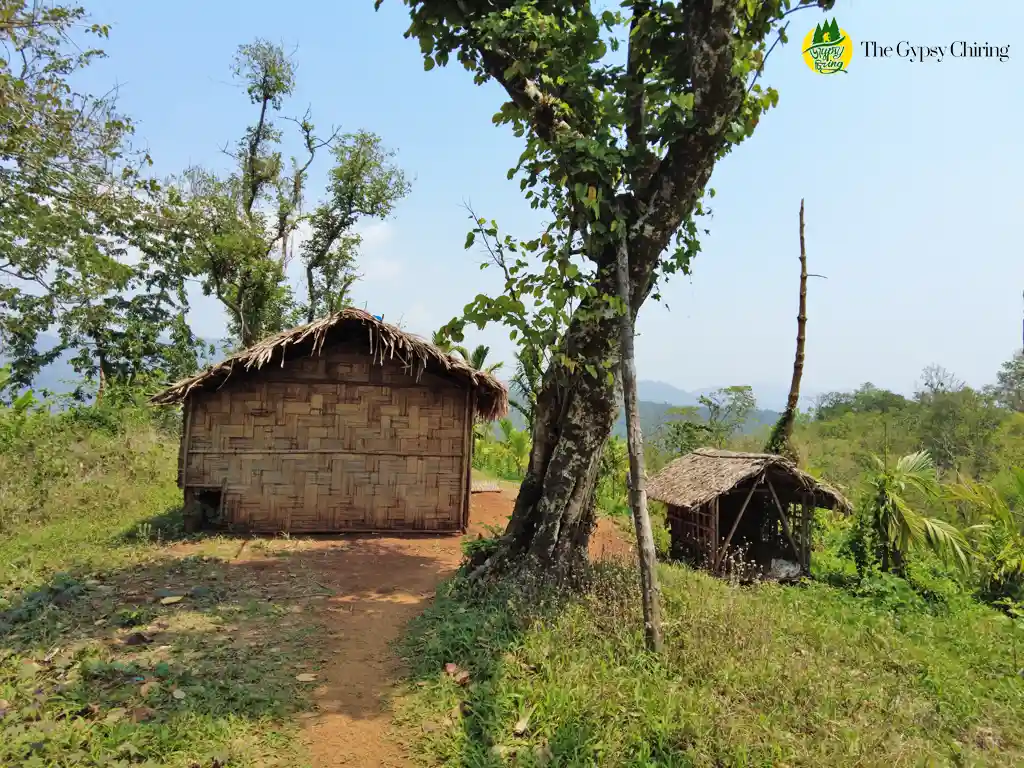
The more you descend the steeper the trail gets. There are stairs made of tea branches to make the descent easier.


Our excitement grew on hearing the sound of the river. Walking for a few more minutes, we reached our destination.
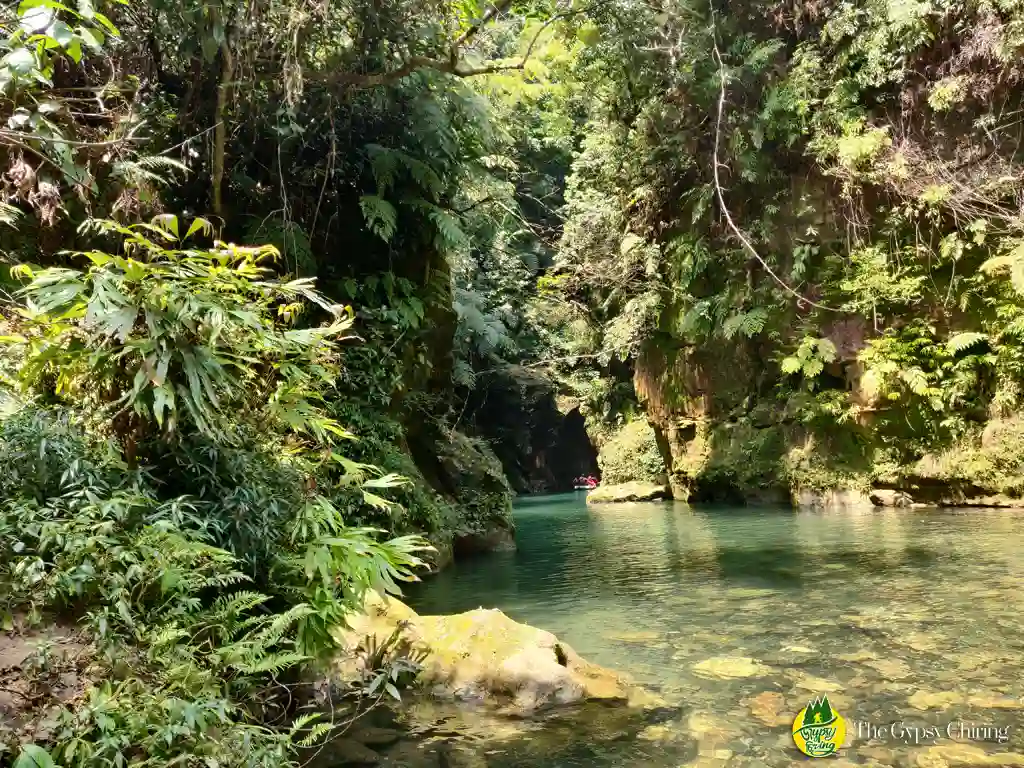

During the weekend particularly on Saturday & Sunday, both domestic and tourists from the different parts of the country visit the Wari Chora tourist spot.

There were limited kayaks and boats. As we waited for our turn, we made the best of the wait by diving and swimming in the clear waters of the Rongdik River.
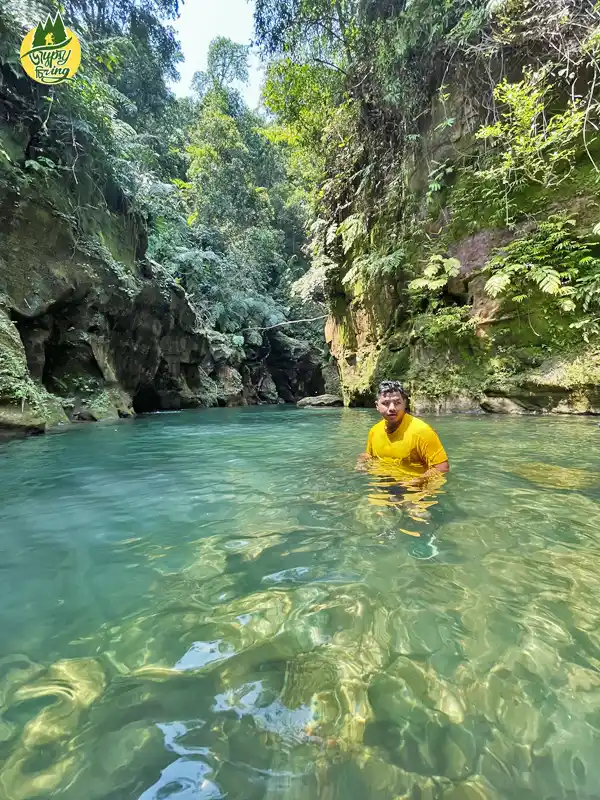
2. Kayaking
The local guides took us on a ride inside the canyons with the help of Canoes, Kayaks and Rafts.
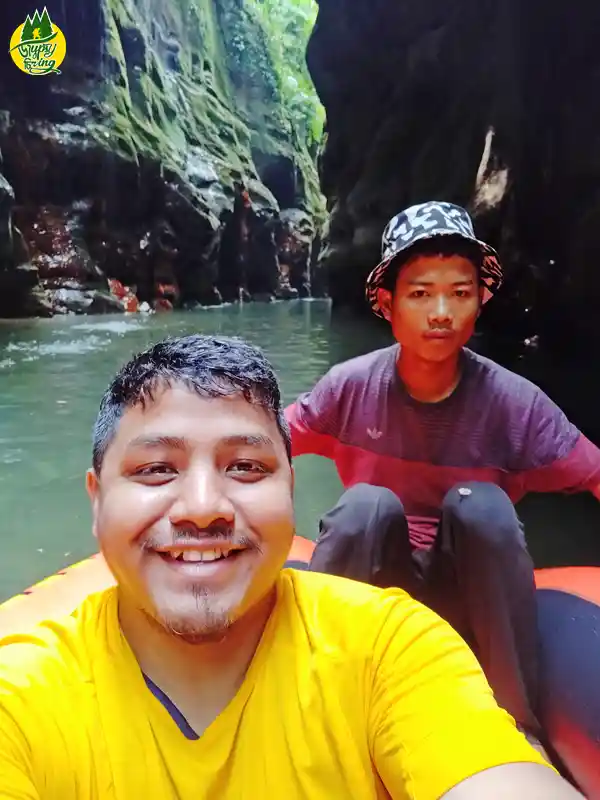
I boarded a single kayak with a Garo guide. Though we couldn’t understand each other’s language, I tried building a rapport by asking him “Nangni Biming Ma?” which translates to “What is your name?” in Garo. He replied, “Pangkam.”

The Canyons looked like the layers and heads of serpents as we kayaked ahead into the river.
The passage narrowed and the sound of the gushing waters of the waterfall roared.

Awestruck! Yes, I was awestruck everywhere I laid my eyes on.
The play of the sun’s rays through the leaves with the colours of the rocks turned the water more turquoise.

The ambience inside the canyon is magical. The Rongdik River which otherwise flows with power, calms down at Wari Chora.
The sensation of water droplets falling from above, the dance of the reflection of light from the water into the rocks and the sight of the tree branches hanging along the passage were beautiful and my favourite moments.
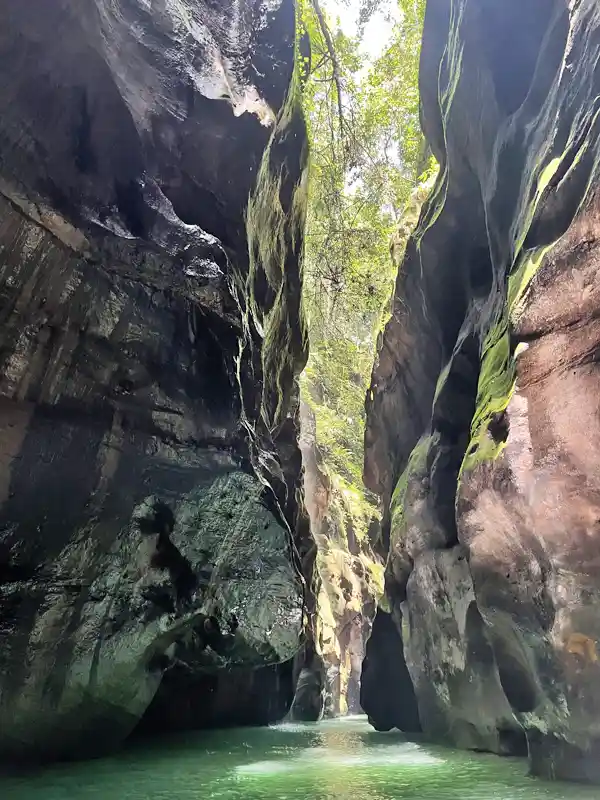
Photo captured by my friend Abhirup during our trip.
3. Swimming
I am that soul who loves to take a dip whenever I see water.
The temptations of Meghalaya’s clear blue waters are such that you can never resist diving or swimming in them.
Our guide mentioned that the depth of the river is about 45 ft.
If you don’t know how to swim, a life jacket is a must.
I initially thought the kayak ride would involve just a round tour without stopping anywhere.
Crossing through the passage of a fallen tree log we reached an area no sort of a wonderland.
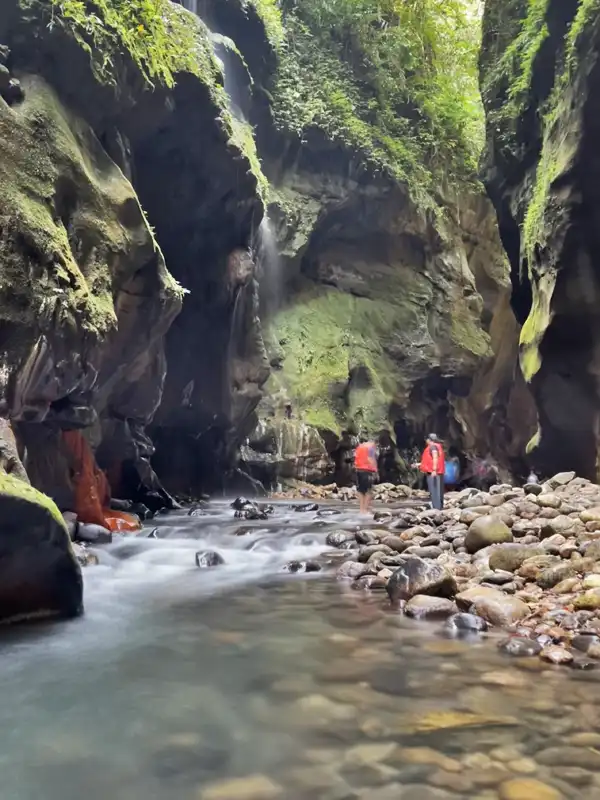

If you are a beginner in swimming, you can swim in two spots in Wari Chora.
Once at the start or later in the spot where the Raft drops you in the shallow waters inside the canyon.
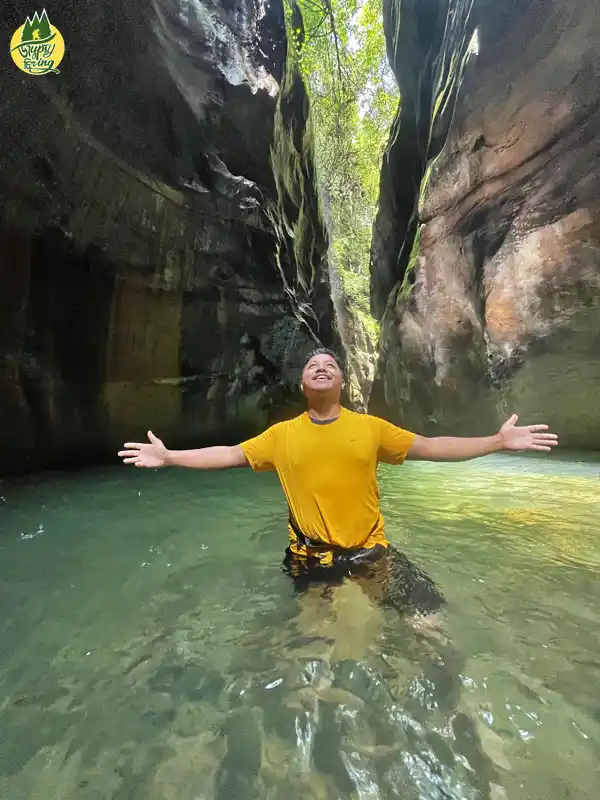
In the world of greenish-brown layered canyons, I felt like time had slowed down when I spread my arms and glanced above.
The tiny drops of water fell from above with elegance and calmness.
4. Cliff Jumping
Though we didn’t do cliff jumping that day, I have seen locals and other visitors cliff jumping at Wari Chora.
Wearing a life jacket will ensure safety during cliff jumping.
Helpful tips for Wari Chora Trip in Meghalaya
1. Start early from Shillong or Guwahati.
This will help you explore Siju Cave and reach Emangre or Baghmara before sundown.
2. Carry a waterproof ocean bag to carry your camera gear or phone at Wari Chora.
I had to repair my phone after the trip as I didn’t take the bag. I saw the phones of others falling into the water too.
3. Support local tourism initiatives such as Baghmara Campers for organizing the tour for you.
Since most trails and tourist spots in South Garo Hills are new, locals are the best guides.
4. Make sure you visit Wari Chora on the weekdays to avoid the crowd of tourists on weekends.
Please Note –
In 2024, a tourist who went solo got lost and was rescued by the local from the middle of a forest.
Therefore, I highly recommend you hire a local guide or tour company to go to Wari Chora.
All Answered FAQs on Wari Chora Meghalaya
Where is Wari Chora?
Wari Chora is in the South Garo Hills District of Meghalaya, India.
Which village is Wari Chora in?
Wari Chora is in Rekmangre Village between Pharomgre and Emangre Village under the Baghmara subdivision of the South Garo Hills District of Meghalaya.
Which airport is near to Wari Chora?
The Lokapriya Gopinath Bordoloi International (LGBI) Airport at Borjhar of Guwahati in Assam is the nearest to Wari Chora.
Guwahati Airport is at a distance of 216 km from Wari Chora, while Shillong Airport in Umroi Meghalaya is at a distance of 296 km.
What is the nearest railway station to Wari Chora?
The Dudhnoi Railway Station in Goalpara is the nearest railway station to Wari Chora.
Dudhnoi is the last town in Assam before entering the East Garo Hills District of Meghalaya.
How to go from Guwahati to Wari Chora?
You can hire or rent a car from Guwahati, and travel for 7-8 hours.
Alternatively, you go to Tura town and then head to Wari chora from there. There is no direct transportation to Wari Chora.
How to reach Wari Chora from Shillong?
From Shillong, buses and sumos go to Tura in the evening and morning respectively.
From Tura, you will have to rent a vehicle to Wari Chora. It takes around 7-8 hours to Tura.
This means, that if you go by public transport, you will reach Emangre or Baghmara very late at night.
I would personally suggest, that you take the help of Baghmara Campers – a local Garo Adventure Company to arrange transportation directly from Shillong.
What is the best time to visit Wari Chora in Meghalaya?
The best time to visit Wari Chora is from November to April.
It can also be visited till the first week of May if it doesn’t rain much and from around September. But it all depends on the rain.
So the next time someone asks when to visit Wari Chora , tell them “from November to April.”
Wari Chora remains closed from May to October.
To get a live update on the weather and whether it’s a favourable time to visit, you can always contact Mark from Baghmara Campers.
Is Wari Chora open now?
Wari Chora opens for tourists from the 1st of November every year.
Sometimes, tours to Wari Chora are also conducted before November. For live updates contact Mark on the number given above of Baghmara Campers.
What is Wari Chora also known as?
Wari Chora is also known as the land of the seven giant serpents.
Is Wari Chora Worth Visiting?
Yes, Wari Chora is worth visiting because of the the serpent-shaped river canyons, clear blue natural water, and the local folklore associated with it.
How much time does it take to reach Wari Chora?
From Guwahati or Shillong to Baghmara or Emangre it takes around 7-9 hours.
From Emangre Village to the Wari Chora trek start point, it is another 8 km off-road which took us about half an hour.
How long is the trek to Wari Chora?
The 1.5 km trek to Wari Chora takes hardly 25-30 minutes while descending.
However, it is the uphill climb of returning to the parking spot that consumes more time.
Depending you don’t rest much while coming up, the trek would take 45 minutes to 1 hour.
Is Wari Chora safe for kids?
Life jackets are provided if needed. Therefore, it is safe for kids.
What is Wari Chora Famous For?
Wari Chora is famous for the turquoise water of river Rongdik passing through the canyon, swimming, rafting and cliff jumping.
Which city is the closest to Wari Chora?
The major city/town closest to Wari Chora is Tura which is 146 km away from it.
Where to stay Wari Chora trip – Hotels, Resorts and Homestays
For the Wari Chora Homestay accommodation, new homestays are coming up in villages like Emangre and Baghmara Town.
We stayed at the Government Tourist Office in Baghmara as arranged by our organizer Baghmara Campers.
At Tura, the closest major town, you can stay at Hotel Polo Orchid Tura.

Wari Chora Tour – Other Places we visited –
1. Dombe Wari
Dombe Wari is a culturally significant place in the South Garo Hills of Meghalaya. It is located just before reaching the Wari Chora parking spot.
You can see it to the right on your journey from Emangre to Wari Chora. We visited Dombe Wari while returning to Emangre.
According to Garo folklore, the gorgeous woman Dombe lived in a Treehouse with her husband Joreng to avoid the attack & capture by the villainous mermen (mermaids who were men).
When the mermen found the couple, they brought down the house along with the Banyan Tree engulfing Dombe in it. This is how the calm Dombe Wari was formed.

During our stay at Tourist Cottages at Baghmara, our guide Tangsen narrated the story and suggested we watch the film Dombe Wari by Doordarshan Tura.
We listened to the story from them and then watched the story on YouTube.
Pretty Ch. Marak on the Northeast Today portal has beautifully narrated the folklore and story of Dombe Wari.
2. Aginma Wari
Aginma Wari is a fish Sanctuary located beside Jamrik Rural Tourist Resort about 3 km from the Emangre Market area.
Aginma Wari and Jamrik Rural Tourist Resort are run by Eman Warima Rural Tourism Cooperative Society Ltd.
After visiting Dombe Wari, we headed to Aginma Wari where our organiser had arranged our lunch.
We were hungry but the refreshing air felt on the ride after the rejuvenating experience at Wari Chora was satisfying.


Aginma Wari & Jawa Wari also have the scope for tourism.
The turquoise waters of the Rongdik River and the fish conservation practice have gradually been able to attract tourists.
3. Jadisil Fish Sanctuary
Jadisil Fish Sanctuary is located at Tolegre Village about 28 km from Emangre Salantini Bajal (Weekly Market Area).
Jadisil is an initiative of the locals and the Department of Fisheries of the Meghalaya government.
This combined effort has helped the local fish species to flourish and increase their population.
By the time we set out on our journey towards Jadisil Fish Sanctuary, the sun was about to set. We reached the sanctuary just before it became fully dark.
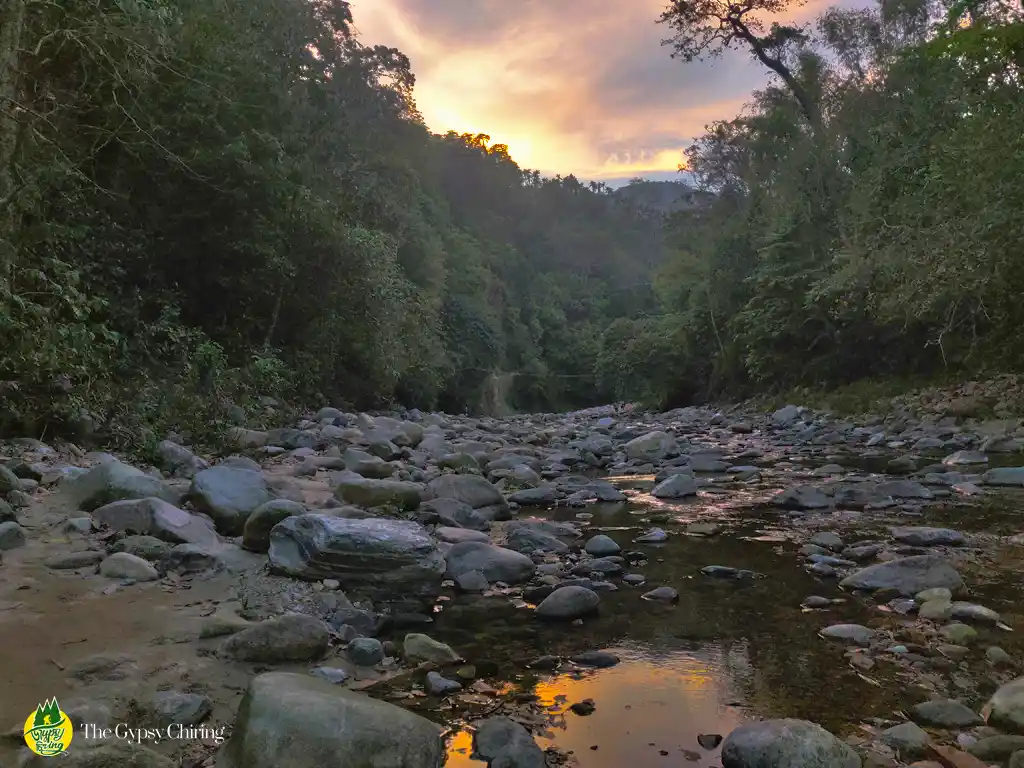
The hike to Jadisil starts from Tolegre Village Playground.
After crossing a few river streams, we climbed the stairs to the right and finally saw a signboard of the sanctuary.
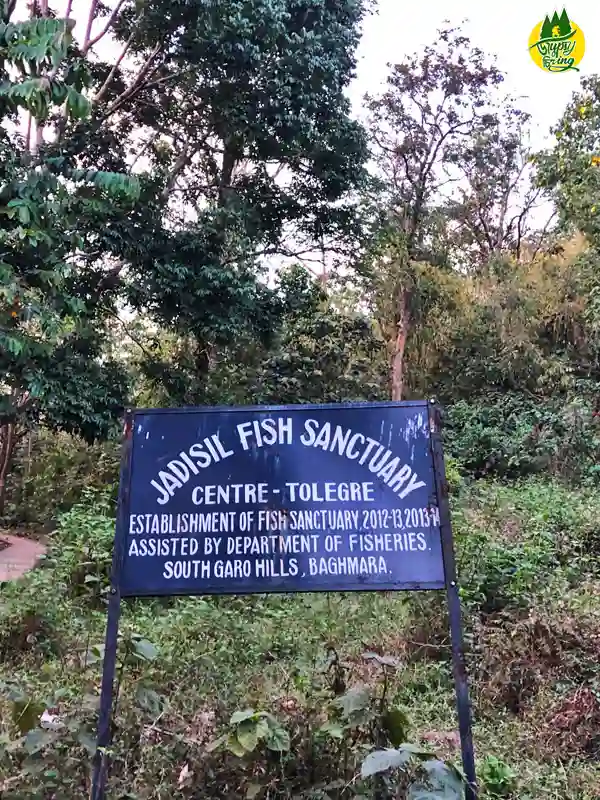
Before heading to the sanctuary, the villagers sold us parched rice (muri) to give to the fish.
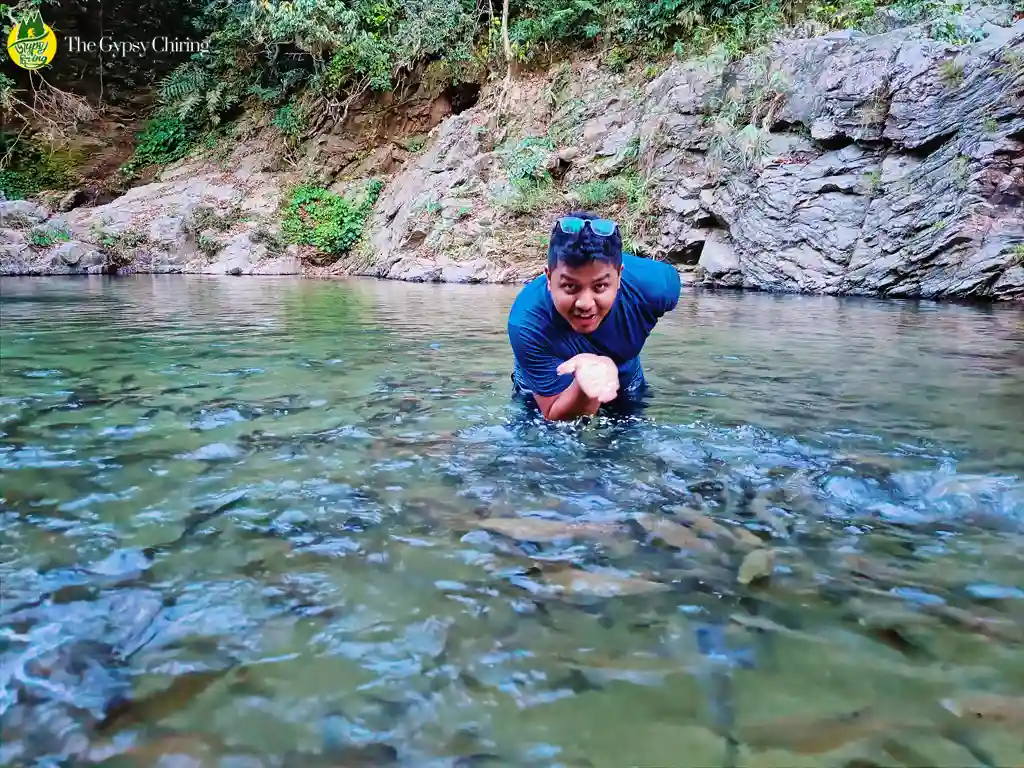
The healthy fishes would round me up as I offered them parched rice. We saw local kids cliff-jumping at the sanctuary too.

Our guide, Tangseng has clicked some amazing pictures of Jadesil. Check this Facebook Post of his.
Here’s one of my favorite picture of Jadesil Fish sanctuary clicked by him –
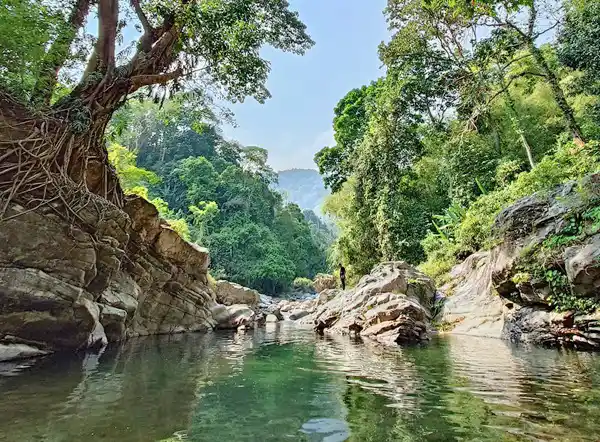
4. Siju Cave
We explored Siju Cave on the 3rd Day i.e. last day of our trip.
Siju Cave is situated about 38 km from Baghmara Town and takes around 2 hours to reach.

The trail to Siju Cave is well-marked and follows well-constructed concrete steps till the beginning of the cave.
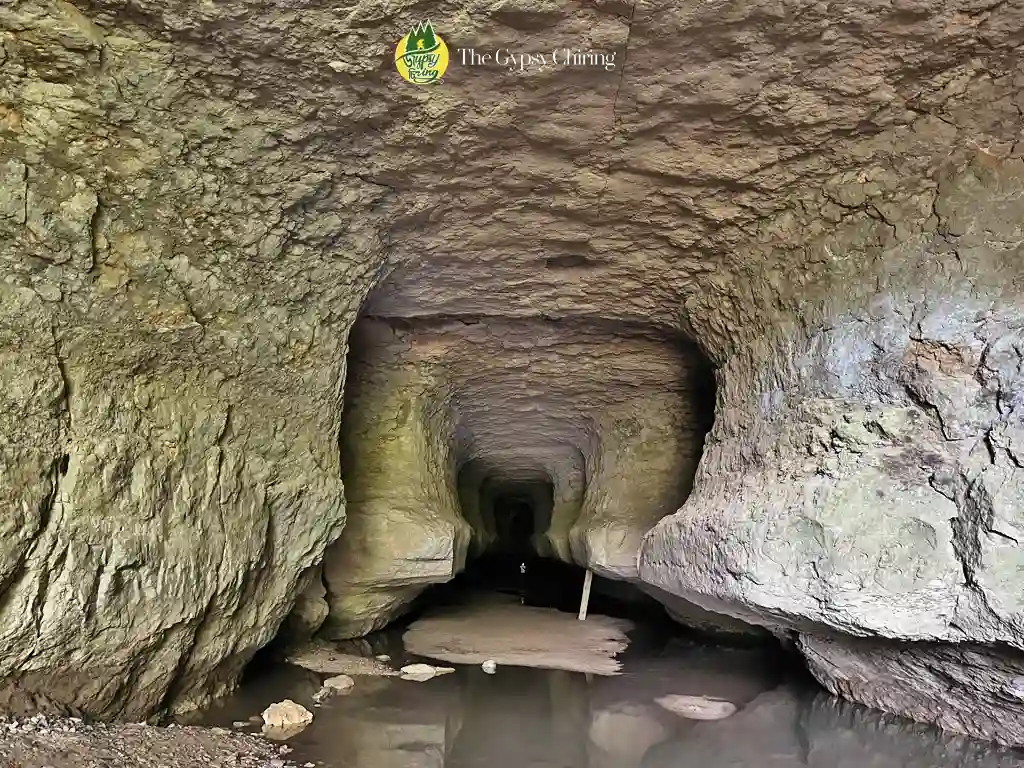
Like Krem Mawmluh in Sohra, Siju Cave in South Garo Hills is one of the longest cave systems in Asia. It is also known as the Bat Cave.

The sun lights up the entrance of the cave. But as we ventured more into the cave, it turned darker. I used my head torch to navigate in the cave.

We crossed a small river stream by a huge boulder to reach the raised surface of the cave.
As we looked up we saw hundreds of bats hanging upside down. It transported us mentally to the cave of Batman in the DC Universe. The ambience was the same.

Summing it Up
I hope this article serves as a guide to exploring places like Wari Chora, Aginma Wari, Dombe Wari, Jadisil Fish Sanctuary and Siju Cave in South Garo Hills of Meghalaya.
Credits go to the local Garo people of the South Garo Hills district for their efforts to promote eco-tourism.
Let’s promote their initiatives and contribute to the local economy.
Before Wari Chora became a favourite tourist spot of Meghalaya, the Garo Hills were mostly visited only for the harvest festival known as 100 Drums of Wangala of the Garo Ethnic group.
The discovery and focus of the local youths and organizations like Baghmara Campers have helped in promoting the tourism scope and Garo folk culture of the South Garo Hills district in Meghalaya.
Baghmara Campers organises tours in all the districts of Garo Hills and Meghalaya. I would highly recommend you contact them to explore the beautiful places of Garo Hills.
Considering the places are new to the tourism realm, we as tourists and tour operators must ensure that over-tourism doesn’t take over.
This trip to South Garo Hills can be your opportunity to learn about the unique culture of the Garo ethnic group. Ecotourism, cultural tourism and nature tourism are the way ahead.
I am grateful to Abhirup brother for clicking the some epic pictures of mine during the trip.
This trip was not only just about adventure and cultural experience, I made new lifelong friends.
Mark these destinations to your Meghalaya Tourist Map for your next visit to the state.
Apart from Wari Chora and the places we visited, there is more to explore in South Garo Hills.
6 new tourist places in South Garo Hills
1. Menggo Kol
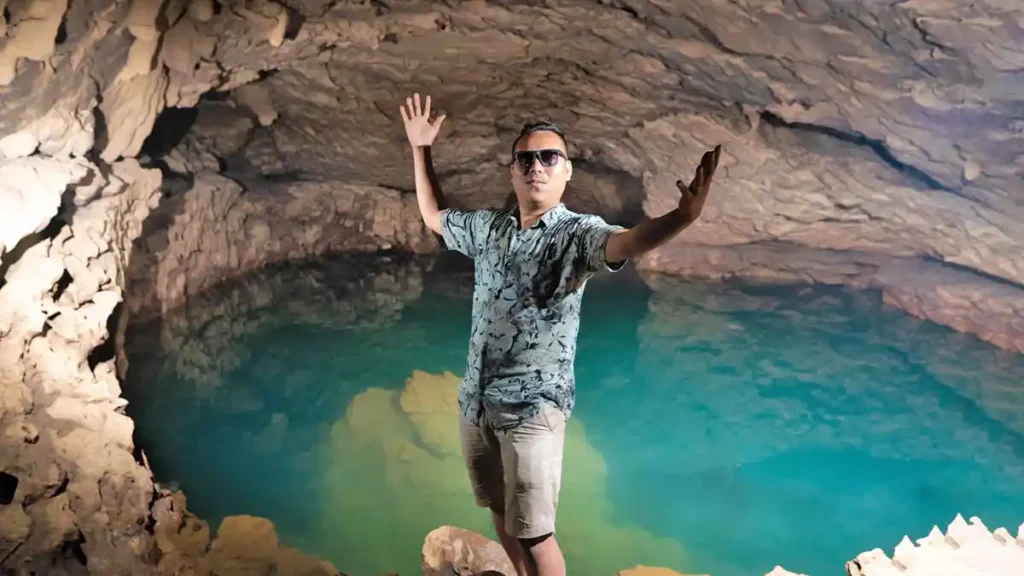
Check this Facebook post by Luckshwell to see more photos of the cave.
2. Balpakram National Park
3. Darechikgre
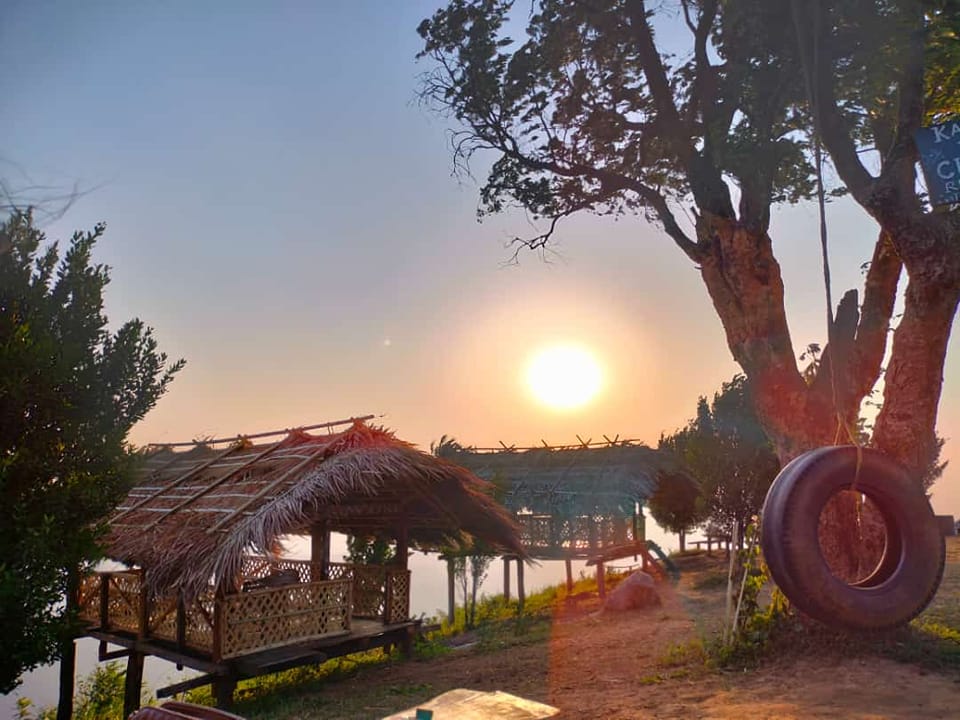
4. Rangram Pattal
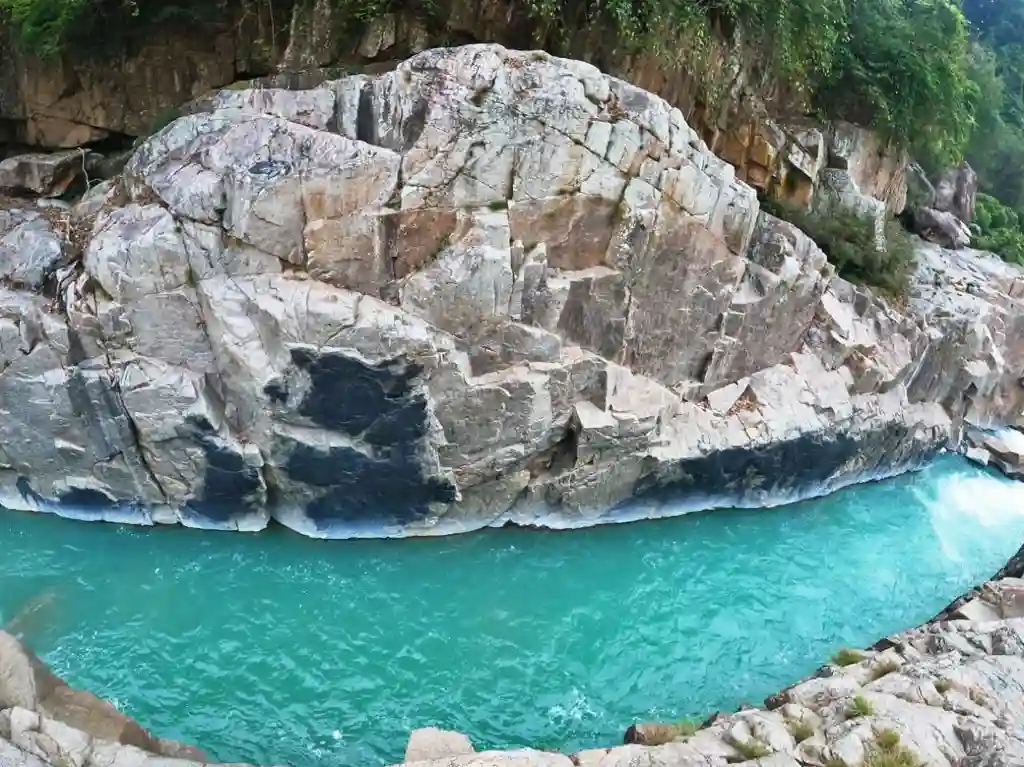
5. Krangchusrik Wari
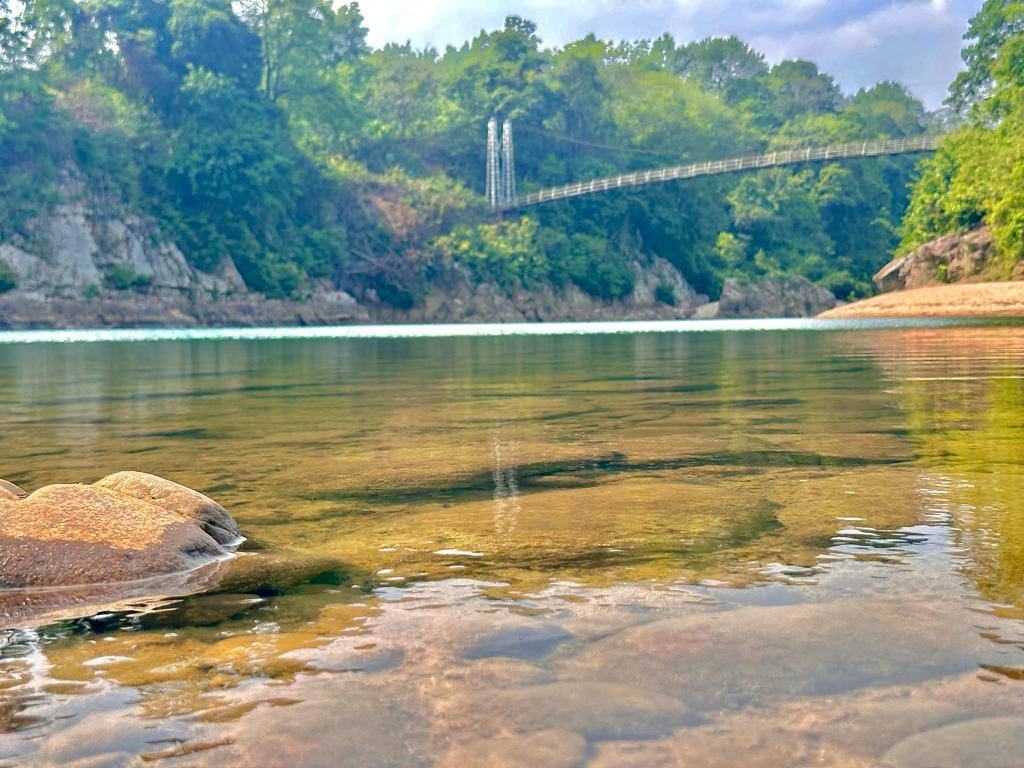
6. Renang Dare Waterfall

Loved Reading the Post? Share it with your travel friends.
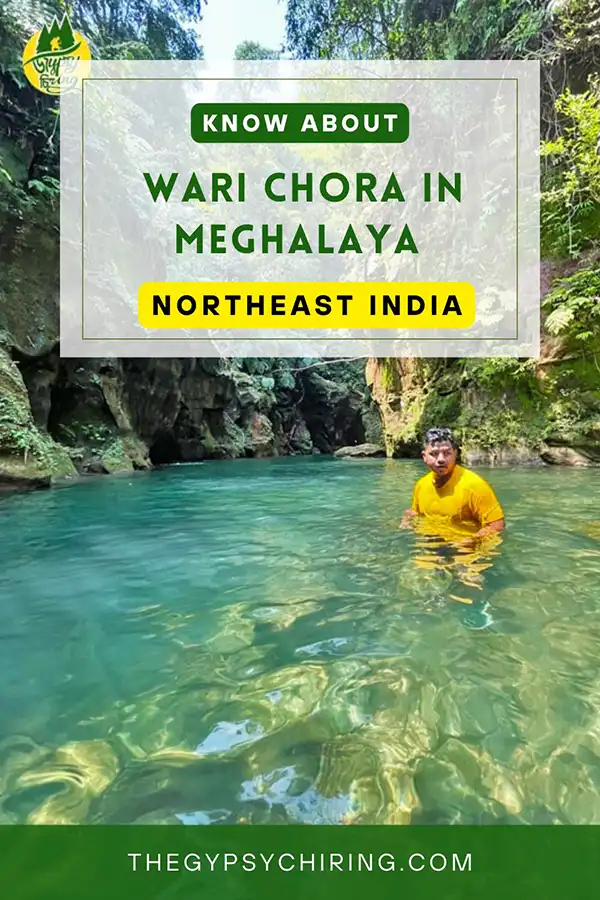
Loved the beautifully written article!! Very well explained and picturised. We are going to visit the south west Garo hills district in August this year. I was wondering if Wari Chora would be open at that time? and will it be worth a visit in monsoon?
Hi Neelam,
Thanks for reading this article about Wari Chora. I am glad you loved it.
I am happy to learn that you would be visiting Garo Hills. In August, it will most probably be closed due to excessive rain. The offroading road from Emangre to Wari Chora trek point would be more muddy and slippery.
But if it doesn’t rain much, it can be visited.
Please get in touch with Mark from Baghmara Campers. The contact number is written on the flyer in the article.
Beautifully described!! I am leaving for Meghalaya next week and I have 1.5 year old infant. I hope that will be able to visit South Garo hills. The journey seems to be very long from Guwahati to Wari Chora! Let’s see.. fingers crossed ✨
Hi Suravi,
Yes, to go to Wari Chora you must keep 3 days extra in your Meghalaya trip. Also, Wari Chora will be closed from next month. I am glad you chose to go in April.
Make sure you attend it during weekdays and not weekends to avoid both local and tourists from other states.
Great! Its really wonderful article cum information guide…. Hope to visit the same in near future… Thank you so much …
Hi Ashoke Kumar Das,
Thank you so much for reading it. You will absolutely love it. Make sure you go with the locals. Mark and his team are great in storytelling about their culture.
Let me know, if you need help when you plan your trip to Wari Chora.
Haven’t even heard about it, but finding it as one of the best destination in Meghalaya, will plan for it soon
Hi Ankita,
Yes, Wari Chora has lately come a popular destination in Meghalaya. As you are planning to visit, make sure you go from September onwards till April. It remains closed from May due to rain and monsoon months.
Beautifully Picturised and Explained. Thanks for sharing Dear..
Hi Shibu,
I am happy that you found the article on Wari Chora helpful. I hope you visit it soon.
This is really a great write up. Am highly benefitted by your penning details. Thanks. Continue the drive and introduce us to various hidden gems of the North East (India)……
Hi Anup,
I am glad that you found the article helpful. Thank you for your best wishes.
Hey, is Wari Chora trekking safe for a yr old boy?
Well, if you do the trip with Baghmara Campers, a guide will be there to help you and your boy. There are a few parts in the trail to Wari Chora where you have to carefully descend down as you can see in the article.
I would suggest you speak to Mark (number in the flyer given in the article). He will clear all your doubts.
Amazing writing Joydeep! Very detailed and perfect in explaining. Loved all your pictures too. Keep posting more. Good luck.
Thanks, Simpi. I hope you visit Wari Chora soon. The season is here. Wari Chora is open to tourists now from November.
Great article Joydeep. Love your enthusiasm to bring offbeat places to the forefront. Wishing you many more exciting journeys ahead.
Hi Lily! I am glad you loved reading it. Northeast India has a huge scope for sustainable eco-tourism. Promoting Northeast India tourism is my goal. Thanks.
Well detailed, I could visualise everything! Keep up the good work
Thanks. Hope to see you joining me in a trip soon.
So very detailed . Loved it. Makes it wanna go to Wari Chora right away
Do plan Soon. I hope you visit both Phe Phe Falls and Wari Chora during your next visit.
Beautiful writing in detail. Definitely will help those who want to visit..
Glad it was helpful.